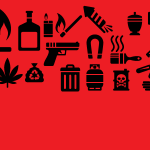We will not carry certain goods and substances. Please check our guidelines on prohibited goods before you arrange dispatch.
To comply with strict regulations we do not carry any substances classified as dangerous in the latest edition of the Civil Aviation Organization’s Technical Instructions.
There are nine hazard classes which cover these and the examples quoted below must not be taken as full lists of all dangerous
goods. We will not accept other materials and products that may be hazardous to our handling staff.
Dangerous goods are defined as those goods which meet the criteria of one or more of the nine UN hazard classes. These classes relate to the type of hazard and are detailed below. All dangerous goods are prohibited.
Class One
Explosives Definition: Any chemical compound, mixture or device capable of producing an explosive-pyrotechnic effect, with substantial instantaneous release of heat and gas. All explosives are prohibited. Examples: Nitroglycerine; Fireworks; Blasting
caps; Christmas Cracker Snaps; Igniters; Fuses; Flares; Ammunition, etc.
Class Two
Gases compressed, liquified or dissolved under pressure. Definitions: Permanent gases which cannot be liquified at ambient temperatures; liquified gases, which become liquid under pressure at ambient temperatures; dissolved gases which are dissolved under pressure in a solvent.
All flammable compressed gases are prohibited. Examples: Hydrogen; Ethane; Methane; Propane; Butane; Cigarette lighters;
Gas Cylinders for camping stoves, blowlamps, etc.
All toxic compressed gases are prohibited. Examples: Chlorine; Fluorine, etc.
All non-flammable compressed gases are prohibited. Examples: Carbon Dioxide; Nitrogen; Neon; Fire Extinguishers containing such gases, etc. iv) All aerosols are prohibited.
Class Three
Flammable Liquids Definition: Liquids, mixtures of liquids, or liquids containing solids in solution or suspension which give off a flammable vapour. Any liquid with a closed cup flash point below 60.5° C is prohibited. Examples: Acetone; Benzene; Cleaning
Compounds; Gasoline; Lighter Fuel; Paint Thinners and Removers; Petroleum; Solvents, etc.
Class Four
Flammable Solids Definition: Solid materials which are liable to cause fire by friction, absorption of water, spontaneous chemical changes, or retained heat from manufacturing or processing, or which can be readily ignited and burn vigorously.
Examples: Matches (any type inc. safety); Calcium Carbide; Cellulose Nitrate products; Metallic Magnesium; Nitro-cellulose based film; Phosphorous; Potassium; Sodium; Sodium Hydride; Zinc Powder; Zirconium Hydride, etc.
Class Five
Oxidizing Substances and Organic Peroxides Definition: Though not necessarily combustible themselves, these substances may cause or contribute to combustion of other substances. They may also be liable to explosive decomposition, react
dangerously with other substances, and be injurious to health. Examples: Bromates; Chlorates; Components of Fibreglass repair kits; Nitrates; Perchlorates; Permanganates; Peroxides, etc.
Class Six
Toxic (Poisonous) and Infectious Substances, Other Medical Substances. Definition: Substances liable to cause death or injury if swallowed or inhaled, or by skin contact. All toxic substances are prohibited. Examples: Arsenic; Beryllium; Cyanide; Fluorine;
Hydrogen Selenide; Infectious substances containing micro-organisms or their toxins which are known to cause (or are suspected of causing) disease; Mercury; Mercury Salts; Mustard Gas; Nitrobenzine; Nitrogen Dioxide; Pesticides; Rat Poison;
Serum; Vaccines, etc. Pathogens in Risk Group 4 and selected Risk Group 3 pathogens listed in Schedule 9, part 5 of the latest edition of the Control of Substances Hazardous to Health Regulations are prohibited. Examples: Clinical, environmental and medical waste; Ebola; Foot and Mouth disease.
Class Seven
Radioactive Material Definition: All materials and samples that are classified as radioactive using Table 2-12 of the latest edition of the International Civil Aviation Organisation’s Technical Instructions. Examples: Fissile Material (Uranium 235,etc.);
Radioactive Waste Material; Uranium or Thorium Ores, etc.
Class Eight
Corrosives Definition: Substances which can cause severe damage by chemical action to living tissue, other freight, or the means of transport. All corrosive substances are prohibited. Examples: Aluminium Chloride; Caustic Soda; Corrosive Cleaning
Fluid; Corrosive Rust Remover/Preventative; Corrosive Paint Remover; Electric Storage Batteries; Hydrochloric Acid; Nitric Acid; Sulphuric Acid, etc.
Class Nine
Miscellaneous Dangerous Goods Definition: Substances which present dangers not covered elsewhere. Examples: Asbestos; Dry Ice (solid carbon dioxide); Magnetized Material with a magnetic field strength of 0.159 A/m or more at a distance of 2.1m
from the outside of the parcel.
(please note: these are general post office prohibitions which would apply to most couriers incl the Post Office)

